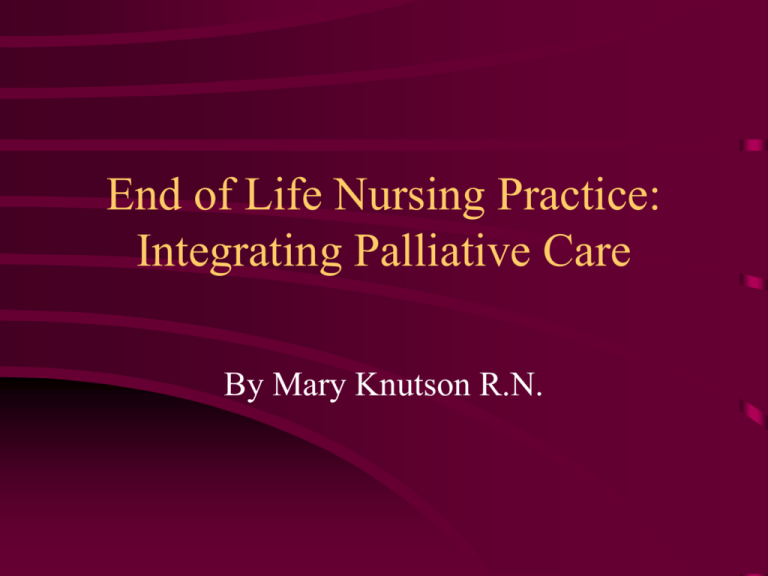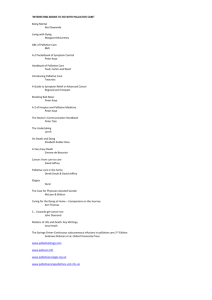pptx - Health Vista
advertisement

End of Life Nursing Practice: Integrating Palliative Care By Mary Knutson R.N. Objectives: • To identify three or more advantages to implementation of palliative care services • To describe two or more barriers to optimal end-of-life care for patients with nonmalignant disease • To develop a strategy for implementing palliative care nursing in your workplace Scope of Problem: • Many nurses are not well prepared to deal with death and dying • Nonmalignant or chronic conditions, (such as cardio-respiratory disease) are usually treated with acute care focus • Nurses are frustrated by giving futile treatments • Lack of a palliative care plan may mean patient is less likely to have a “good death” • Palliative care vs. hospice care is not well understood Definition of Palliative Care: • An approach that improves the quality of life of patients and their families facing the problems associated with life-threatening illness, through the prevention and relief of suffering by means of early identification and impeccable assessment and treatment of pain and other problems, physical, psychosocial, and spiritual ---World Health Organization (2004) WHO Definition (Continued): • Affirm life and regard dying as a normal process • Neither hasten nor postpone death • Provide relief from pain and other distressing symptoms • Integrate psychological and spiritual aspects of care • Offer a support system to help patients live as actively as possible up to death • Use a team approach to address the needs of patients and their families • Offer a support system to help the family cope during the illness and their own bereavement Is Palliative Care Different than Hospice? Hospice services include palliative care Palliative care may be offered at any point in an illness, not just close to the end of life Hospice is appropriate when death is expected within six months Both palliative care and hospice care include services for patients with non-malignant diseases For example, CHF or ESRD (End Stage Renal Disease) Why is Palliative Care Important to Nurses? • Most Americans dread the thought of their own death and fear a medically intrusive dying process – Death and dying are too rarely discussed – Communication among patients, their families, and health care providers is often lacking • There is a need for better end-of-life care in the United States – Nurses have the most intimate and continuous contact with patients and families during that phase of life Models of Care: • Acute Care/episodic management – Curative, treatment focus – Increased specialization/compartmentalization • Palliative care benefits are often denied • Palliative care services/holistic, integrative care –Focus is on care, not cure –Avoids end-of-life conflicts in acute settings Challenges for Physicians: • Limited training in palliative care • Traditional education models are less effective for values, communication, and behavior skills • Dealing with others’ emotions requires insight into their own • Physicians are often invested in a relationship built on hope for cure • Patients and families may have unrealistic goals • Significant time constraints Challenges for Nurses: Ethical dilemmas • Difficulty in determining prognosis – “All I need is a green light” • Interns hesitate to order palliative care when attending physician is unavailable – But, “End stage should mean end stage, no matter what the disease” • Discussions about resuscitation should be done prior to clinical emergencies Challenges (Continued): • Nurses may be confused and frustrated about what the DNR order means – How far do you go with invasive treatments? • Patients must be given realistic expectations of prognosis and treatment outcomes – What are the patient’s current desires and wishes/advance directives? • Acute care and critical care areas may not be conducive to palliative care/comfort care How to “Shift the Picture”: • • • • • • Work together Hold family meetings Create new expectations Change scope of choice Change the value of treatment options Change indicators A Nurse’s Quote: • I’m very careful to work in concert with physicians in my setting so that the family isn’t hearing from the physician, “Press on, press on,” and from the nurse, “Why are we doing this?” Because that creates incredible distress for families. How to Help Patient and Family Accept a “New Picture”: • Involve others • Redirect hope • Repeat and reiterate information Avoid far-away relatives demanding aggressive treatment for patient by involving them in family meetings (with conference calls), and providing regular updates by phone End of Life Discussions: • • • • • Break bad news sensitively Provide information as the patient wishes Permit expression of emotion Clarify concerns and problems Involve patient and family in making decisions about treatment • Set realistic goals • Provide appropriate medical, psychological, and social care, and promote continuity of care “Lifting the Heart”: A week ago nothing mattered I didn’t want to do anything I just wanted to die Today something lifted my heart up Somebody had built some flowers The newness of new crocuses Poem written by a man who had been diagnosed with a brain tumor Learning Palliative Care: • Physicians and nurses want to learn: – How to talk to families and dying patients – How to effectively treat pain • Curriculums should be modified to include: – Interactive courses with role-playing – Less emphasis on doing something, and more on being with patients in palliative care – Discussion of “human” aspects of care Learning Palliative Care (continued): • Include clinical rotations in palliative care centers, if available – Observe nurse and physician role models • Use innovative education programs like e-mailed “Fast Facts” • Use palliative care content to combine teaching – Review charts for effective pain/symptom management – Practice related communication skills – Discuss medical ethics and health law cases Palliative Care in Nursing Education: • As the percentage of aging population increases, so will the need for competent end-of-life care • Students need clinical opportunities to care for dying individuals • Faculty knowledgeable in end of life care are needed in clinical education settings – Complex care management – Emotional support and ethical guidance needed Nursing Students Need To Know: • Pain and symptom management • Grief, loss and bereavement issues • Communication skills • Cultural considerations • Ethical and legal issues • Quality end-of-life care • Standards of practice for sound clinical judgment in pain management • Acute, chronic, and end-of-life pain issues • Assurance that nurses are supported for providing appropriate pain management Integrating Palliative Care into Nursing Curriculum: • Education – Knowledge and skills • Collaboration – Interdisciplinary approach • Accountability – Advocacy for all dying individuals and their families Palliative Care Policy Issues: • Nursing shortage and reimbursement barriers threaten access to palliative and end-of-life care • Palliative care is affected by various social, organizational, and economic policies • Key goals include the integration of palliative care – Throughout the course of illness – Promote earlier referral to palliative/hospice services • Advanced practice nurses are key to providing continuing education to practicing nurses Implications for Nursing: • Nurses advance improvements in palliative and end-of-life care – Involvement in educational, quality improvement, research, and legislative initiatives • Nursing activities improve access, lower costs, and improve quality of care in advanced illness • Nurses initiate palliative care interventions with multidisciplinary approach Conclusion: • Palliative care is appropriate in hospitals, long-term care, home health care, and community settings • Nurses should promote palliative care for patients unresponsive to curative treatment • Barriers to palliative care decrease when advance directives are discussed by patients, nurses and physicians • Guide physicians to provide palliative care for patients with malignant and non-malignant illnesses This Powerpoint was created in 2004 as a graduate student References: • Arnold, R. (2003). Challenges of integrating palliative care into postgraduate training. Journal of Palliative Medicine. 6, 801-807. • Barraclough, J. (1997). ABC of palliative care: Depression, anxiety and confusion. British Medical Journal. 315(7119), 1365-1368. • Davidson, P., Introna, K., Daly, J., Pauli, G, et al. (2003). Cardiorespiratory nurses’ perceptions of palliative care in nonmalignant disease: Data for the development of clinical practice. American Journal of Critical Care. 12(1), 47-53. • Gilligan, T. (2003). When do we stop talking about curative care? Journal of Palliative Medicine. 6, 657-660. • Haylock, P. J. (2003). TNEEL: A new approach to education in end-of-life care. American Journal of Nursing. 103(8), 99-100. • Norton, S. A. & Bowers, B. J. (2001). Working toward consensus: Providers’ strategies to shift patients from curative to palliative treatment choices. Research in Nursing and Health. 24, 258-269. • Pimple, C., Schmidt, L., & Tidwell, S. (2003). Achieving excellence in end-of-life care. Nurse Educator. 28(1), 4043. • Reb, A. (2003). Palliative and end-of-life care: Policy analysis. Oncology Nursing Society. 30(1), 35-50. • World Health Organization. (2004). WHO definition of palliative care. Retrieved October 9, 2004 from http://www.who.int/cancer/palliative/definition/en/







